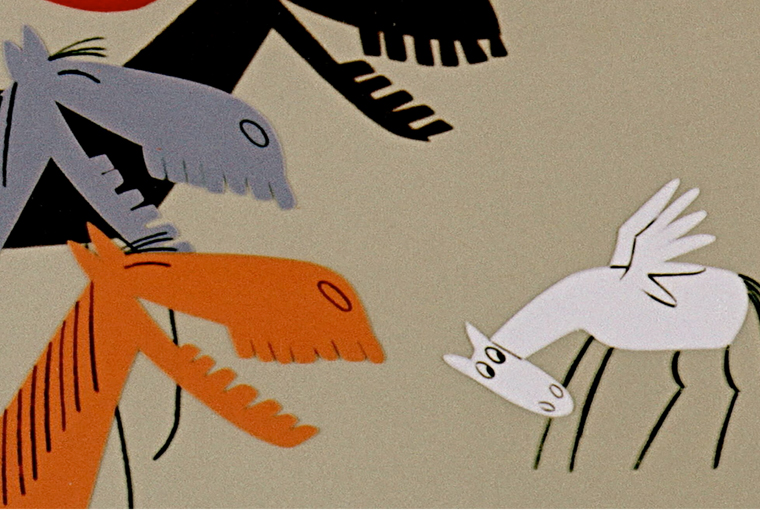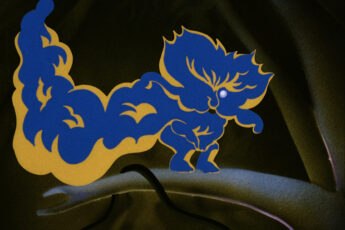Hungarian Animation Filmmakers and their Quest for Self-Expression
Four Animated Shorts from the Pannónia Filmstúdió
Vol. 141 (January 2024) by Julia Skala
At the 2023 goEast Film Festival in Wiesbaden, the audience was presented with wondrous and colorful Hungarian animation films from the 1960s, 1970s and 1980s. Among them was not only Marcell Jankovics’ 1981 animated feature film Son of the White Mare, but also a variety of short films hailing from the Pannónia Filmstúdió, four of which will be discussed in this article, namely The Grid (A rács, 1971), Ten Grams of Immortality (Tíz deka halhatatlanság, 1968), I Like Life A Lot (Nekem az élet teccik nagyon, 1976), and Moon Flight (Holdmese, 1975).
The Pannónia Filmstúdió was founded in 1951 as the 2D animation department of the Hungarian national film production studio MAFILM. After the Second World War, Hungarian film production had been nationalized and merged into what would become the Magyar Filmgyártó Nemzeti Vállalat – MAFILM. Pannónia Filmstúdió, whose name is derived from a former Roman province that incorporated parts of contemporary Hungary, became an independent studio in 1956. It was led by Gyula Macskássy, who had been the head of MAFILM’s animation department before. Pannónia went on to produce short films and, starting in the 1970s, feature films too. In 1981 the locally produced short film The Fly, directed by Ferenc Rófusz, was the first-ever Hungarian production to receive an Academy award. By the 1980s, Pannónia Filmstúdió was considered to be one of the largest and most relevant animation studios worldwide alongside the Walt Disney Studios, Hanna-Barbera (United States), Soyuzmultfilm (Soviet Union/Russia), and Toei Animation (Japan). The artists and directors active at the Pannónia Filmstúdió championed different styles and approaches to animation, as is reflected in the films showcased at goEast.
Gyula Macskássy co-directed both The Grid (1971) and Ten Grams of Immortality (1968) with György Várnai. Both films are animated parables. The first, very short film depicts a prisoner, who, craving sunlight and perspective, draws an additional window onto his prison cell wall. The guard corrects his drawing by adding the prison bars to the scribble, ultimately reminding the audience that artists’ dreamed-up freedom and space for individuality are being limited and repressed by the authorities. In Ten Grams of Immortality, a Pegasus horse is continuously mocked and excluded in whatever role it tries to fulfill in society, be it a racehorse or a singing bird. In the end, the horse is butchered and made into a winged sausage, which gives wings and inspiration to the writer eating it, easing his writer’s block. The parable is thus reflective of a normative society that imposes conformism on its subjects and hints at the problematic role of artists within it. The visual style, graphic characters, and use of color planes and lines in both of these short films is strongly reminiscent of the animation style of United Productions of America, better known as UPA. Founded in the 1940s in the United States, UPA also thrived with a reduced, graphic, Art Nouveau-infused cartoon style throughout the 1960s and 1970s.
Kati Macskássy (the daughter of Gyula) helmed the short film project I Like Life a Lot (1976), which was animated and narrated by school children from the Roma community aged between 9 and 14. Their tales of everyday life in their community involve discrimination and ridicule from other – non-Roma – children, alcoholic parents, as well as observations of prostitution and forced marriages of their 12-year-old female peers. The visual style varies with each story and the respective child narrating it. Yet, drawn in playful shaky lines and mostly illustrated with expressive, joyful, oil pastel colors, their perception of life is unshakably optimistic. Despite also talking about their saddest moments in life, their conclusion seems to be deeply life-loving (as the title suggests).
Sándor Reisenbüchler directed Moon Flight in 1975 after having won a Palme d’Or in Cannes with his short film The Year 1812 (1972). Moon Flight takes us on a utopian space-journey, drawing real-life footage from the lunar race between the Soviet Union and the United States that is occasionally interspersed with intertitles. Reisebüchler’s films have a very distinctive visual style. Drawing from found footage and layering collages in the wildest of colors, he creates his cutout animation films – playing with abstract patterns and graphic shapes, experimenting with exposure to light on analog film, and even with liquid animation. The result is an appealing, artistic take on sci-fi design that seems to be strongly influenced by both dadaism and psychedelic art (which was widespread at the time).
All of the short films above impress with a confident, experimental use of colors and narration. The narrative tone often feels cynical and a bit morbid. In Ten Grams of Immortality, a tale of societal discrimination, little Pegasus does not ultimately find his place in society but is instead butchered. As for I Like Life a Lot, the children do not yet seem to grasp how tragic and bitter their stories are. The Pannónia short films showcased at goEast were made at a time when the so-called third generation of Hungarian animators was still under pressure from the government. Films like The Grid depict the threat of persecution that artists faced very tangibly. At the same time, there is an ever-strong longing for artistic individuality, self-expression, and for freedom and utopias, as shorts such as Moon Flight illustrate.
In contrast to animation studios like the Walt Disney Studios, Pannónia Filmstúdió did not establish a „corporate style“ as a studio. Although it was commercially successful, the studio continued to operate as an artistic group of animation directors – auteur filmmakers – who could continue to pursue their personal styles and/or develop a fitting one for each particular project.
This heritage of personal artistic expression in animation has surely influenced today’s animation scene in Hungary. The Moholy-Nagy University of Art and Design Budapest (MOME) is well-known for educating animation directors and animators in a variety of personal styles and voices. Their common ground is, well, being different. The versatile Hungarian animation scene that we observe nowadays, with independent directors like Réka Bucsi or Balázs Turai, naturally follows in the footsteps of Pannónia Filmstudio and continues to surprise and refresh.




Leave a Comment